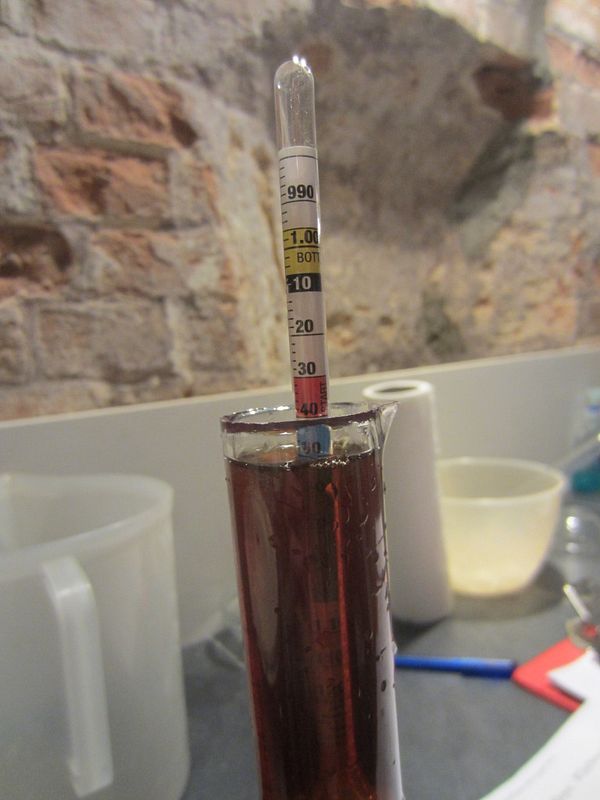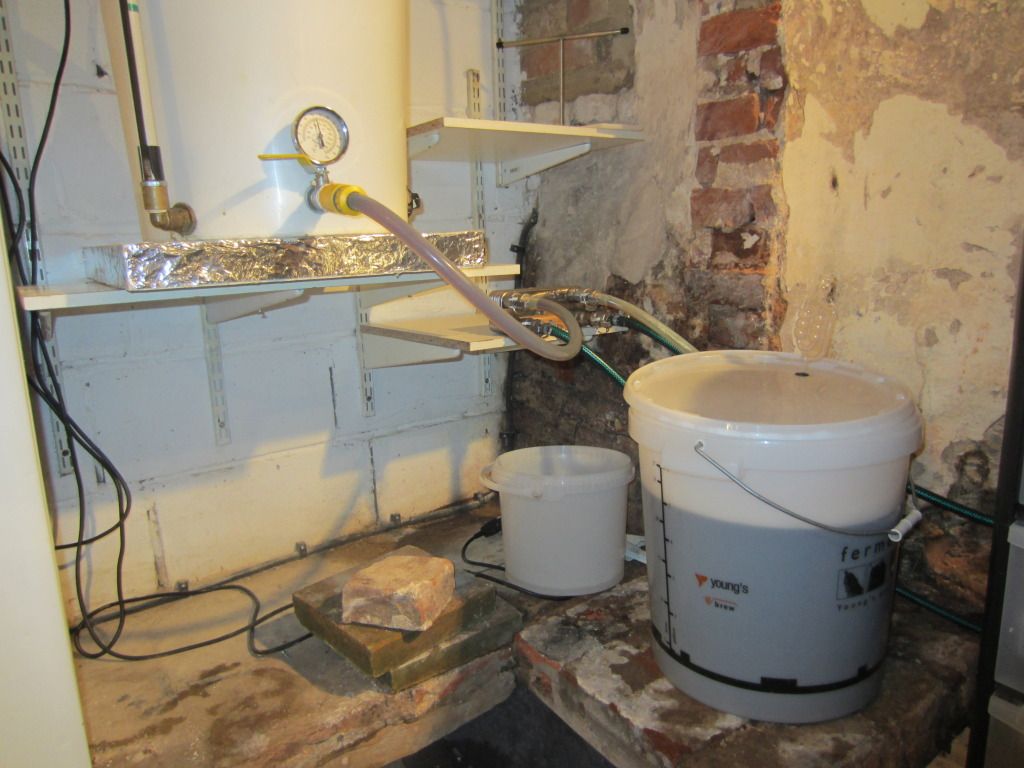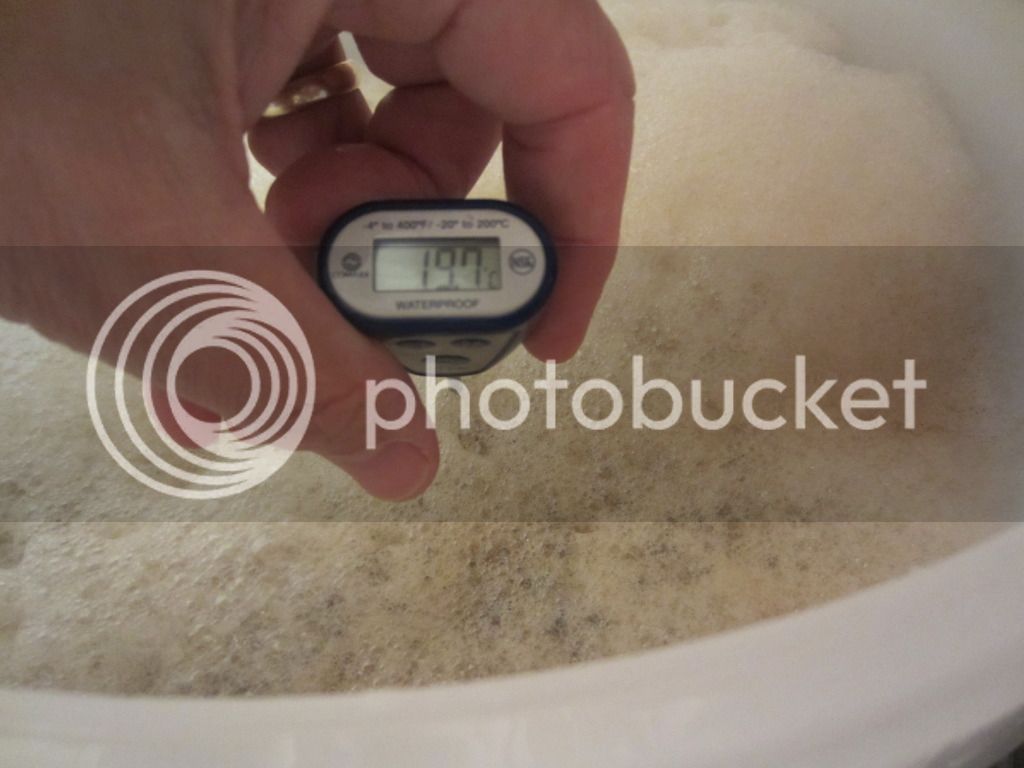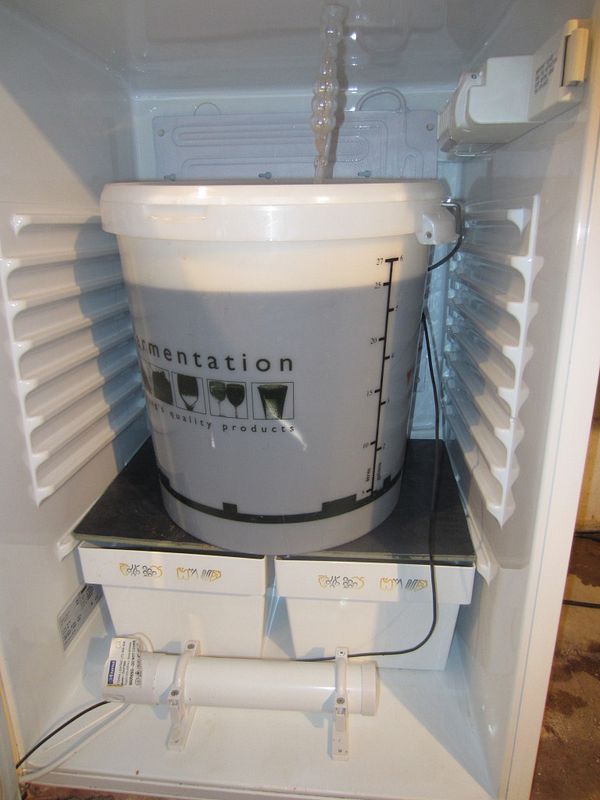I thought this brew day might be of particular interest to those of you interested in historical brewing. This was inspired by a forum member fuggledog (Ben Heaven) over at Jim's who was in turn inspired by Ron Pattinson's research on historical recipes to kiln his own malt. I was intrigued by his post and he has kindly kilned some mal,t in the manner it would have been done in the early 19c, for me to use (charging relatively little, thanks Ben).
The malt is kilned over oak to around 550 EBC and is a brown porter malt with no or little diastatic power. This lead me to debate the value of mashing this but I decided to do so as this was the recommendation. My reservation arose from reading and listening to Gordon Strong on the usual practice of mashing all grains together regardless of the fact that there are obviously no enzymes left to convert the malt sugars, and that mashing at higher temps will extract harshness and bitterness from roasted malts.
Another aspect to the recipe was multi gyle boiling and the use of "aged" hops. Ben had worked out what the bittering potential was and suggested a 1:1 IBU ratio. As for the boiling his own experiments suggest that you can achieve the "intire" effect with a 90 minute boil. From this it is arguable that I haven't exactly replicated the recipe, but as homebrewers we know we can only ever really get close even to modern brews, given our limitations. For me the key to the brew is how the brown malt performs, kilned as it is over oak.
Recipe
4.00 g Gypsum (Calcium Sulfate) (Mash 60.0 mins)
4.150 kg Pale Malt, Maris Otter (5.9 EBC) 73.5 %
1.500 kg Brown Porter Malt (circa 19th century) - Oak (550.0 EBC) 26.5 %
60.00 g Goldings, East Kent [7.20 %] - First Wort 90.0 min 48.4 IBUs
1.0 pkg Fat Cat Yeast (Fat Cat Brewery #Charles Wells Brewery)
Beer Profile
Est Original Gravity: 1.050 SG Measured Original Gravity: 1.051 SG
Est Final Gravity: 1.015 SG Estimated Final Gravity: 1.015 SG
Estimated Alcohol by Vol: 4.6 %
Bitterness: 48.4 IBUs Calories: 481.9 kcal/l
Est Color: 79.7 EBC
Brew length 25 litres
The mash is obviously important for this brew as I want it to have a lot more body than my standard beers so mashing high was the key. Doughed in at 75.8c with a mash target of 68.9 (started at 69.4 finished at 68.8). Disappointingly the CRS was much more aggressive at lowering PH and this malt, being a little more acidic, lowered the mash PH even more (around 4.6 which at room temp is likely to be .3 lower so a real worry, any comments?) I usually fly sparge but Ben recommended I went for a batch sparge. As my mash tun is large enough I also went for a 1 step sparge, draining the tun (slowly) into the boiler containing all the hops, then recharging the tun with 27 litres of CRS treated water at a much higher temperature than usual but the HLT produced water 2c under target at 73.5. Mash steep temp was 72.4, replaced the lid and thermal cover for 10 minutes. Run off was slowed right down to improve extraction and took 45 minutes. Thought about 15 minutes and arguably should have done but BS2 calculated extraction rate achieved as an astonishing 87.2% so I don't think this mattered. Upshot was I hit all my liquid targets and achieved an OG of 1.051 against a predicted 1.050. I tasted the first runnings and expected harshness or bitterness but was surprised by how smooth it was, there was a very slight hint of smoke but I may have been overly influenced by knowing how it was kilned.
I took pictures but unfortunately somehow lost the early mash shots which are the most interesting. Sorry for the rather boring ones to follow.
Post boil trub, it was thick & dark

OG shot

Crash cool

I like a low start and it ended up a little higher than usual as I had a problem with the chiller. I hadn't opened up the valve for running the warm water away and so it went into FV at about 30+ before I noticed.

Tucked up set at 20c to encourage a litle ester. Will raise by 2 degrees when fermented out to reduce diacetyl.

The malt is kilned over oak to around 550 EBC and is a brown porter malt with no or little diastatic power. This lead me to debate the value of mashing this but I decided to do so as this was the recommendation. My reservation arose from reading and listening to Gordon Strong on the usual practice of mashing all grains together regardless of the fact that there are obviously no enzymes left to convert the malt sugars, and that mashing at higher temps will extract harshness and bitterness from roasted malts.
Another aspect to the recipe was multi gyle boiling and the use of "aged" hops. Ben had worked out what the bittering potential was and suggested a 1:1 IBU ratio. As for the boiling his own experiments suggest that you can achieve the "intire" effect with a 90 minute boil. From this it is arguable that I haven't exactly replicated the recipe, but as homebrewers we know we can only ever really get close even to modern brews, given our limitations. For me the key to the brew is how the brown malt performs, kilned as it is over oak.
Recipe
4.00 g Gypsum (Calcium Sulfate) (Mash 60.0 mins)
4.150 kg Pale Malt, Maris Otter (5.9 EBC) 73.5 %
1.500 kg Brown Porter Malt (circa 19th century) - Oak (550.0 EBC) 26.5 %
60.00 g Goldings, East Kent [7.20 %] - First Wort 90.0 min 48.4 IBUs
1.0 pkg Fat Cat Yeast (Fat Cat Brewery #Charles Wells Brewery)
Beer Profile
Est Original Gravity: 1.050 SG Measured Original Gravity: 1.051 SG
Est Final Gravity: 1.015 SG Estimated Final Gravity: 1.015 SG
Estimated Alcohol by Vol: 4.6 %
Bitterness: 48.4 IBUs Calories: 481.9 kcal/l
Est Color: 79.7 EBC
Brew length 25 litres
The mash is obviously important for this brew as I want it to have a lot more body than my standard beers so mashing high was the key. Doughed in at 75.8c with a mash target of 68.9 (started at 69.4 finished at 68.8). Disappointingly the CRS was much more aggressive at lowering PH and this malt, being a little more acidic, lowered the mash PH even more (around 4.6 which at room temp is likely to be .3 lower so a real worry, any comments?) I usually fly sparge but Ben recommended I went for a batch sparge. As my mash tun is large enough I also went for a 1 step sparge, draining the tun (slowly) into the boiler containing all the hops, then recharging the tun with 27 litres of CRS treated water at a much higher temperature than usual but the HLT produced water 2c under target at 73.5. Mash steep temp was 72.4, replaced the lid and thermal cover for 10 minutes. Run off was slowed right down to improve extraction and took 45 minutes. Thought about 15 minutes and arguably should have done but BS2 calculated extraction rate achieved as an astonishing 87.2% so I don't think this mattered. Upshot was I hit all my liquid targets and achieved an OG of 1.051 against a predicted 1.050. I tasted the first runnings and expected harshness or bitterness but was surprised by how smooth it was, there was a very slight hint of smoke but I may have been overly influenced by knowing how it was kilned.
I took pictures but unfortunately somehow lost the early mash shots which are the most interesting. Sorry for the rather boring ones to follow.
Post boil trub, it was thick & dark

OG shot

Crash cool

I like a low start and it ended up a little higher than usual as I had a problem with the chiller. I hadn't opened up the valve for running the warm water away and so it went into FV at about 30+ before I noticed.

Tucked up set at 20c to encourage a litle ester. Will raise by 2 degrees when fermented out to reduce diacetyl.



























![BREWING THERMOMETER STICKERS ACCURATELY MONITOR FERMENTING BEER & WINE LIQUID TEMPERATURES 5PCS HOME BREW SPIRITS WINE LCD ADHESIVE [US]](https://m.media-amazon.com/images/I/311DDjo2X3L._SL500_.jpg)















